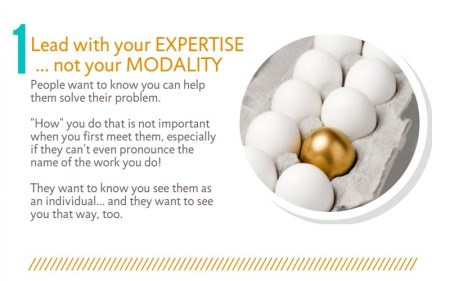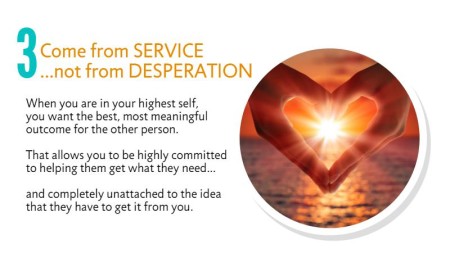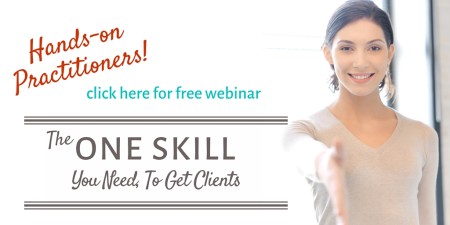It doesn’t take psychic ability to know that you probably hate the part of your job that has to do with getting your own clients and helping them commit to working with you.
Getting my own clients was the part of my practice that I hated, too, until I learned to do it so that it felt like me… when what you’re doing works and feels like you, you’ll do it more and more… and helping clients commit will become just another part of a great day in your practice.

To make it easy to help clients commit, focus on 3 essentials most people miss
These three things help you get yourself out of the way so that your potential clients can talk themselves into working with you. When you know how to make it easy to help clients commit, you’ll do it more often, more easily and with happier results.
The best part is that there’s no selling involved!
What gets clients to say “YES!”—is getting 3 things right in the background. When you take the time to master them, you’ll find that you’re helping more and more clients get the transformation only you can offer!
Essential #1: Lead with your EXPERTISE… not your MODALITY
 You’ve devoted a major chunk of your life to becoming a practitioner, and I know that you’ve been transformed by the work you practice.
You’ve devoted a major chunk of your life to becoming a practitioner, and I know that you’ve been transformed by the work you practice.
The desire to help others transform in a similar way is a major driving force for every practitioner I’ve ever worked with. It was for me, too.
That’s why I know it cuts to the quick to hear that people are not talking to you because they are interested in your modality.
In fact, most of the folks you talk to about working with you are never going to be as interested in your modality as you are.
Why not?
The reality is both simple and painful: People have problems. They are looking for solutions… and what they want to know is: do you have solutions that will work for them?
If you do, and you let them know that, their interest in talking to you goes up.
If you insist on talking about what’s interesting to you (in other words: your modality), they’ll find a way to disengage.
Beware of the rare case where people are genuinely interested in hearing more and more about the finer points of your work: usually it’s an indication that their interest is cerebral and they they are not looking for solutions—and that means they are never going to hire you. The people who are interested in becoming your clients are most often concerned with solving their problems.
Essential #2: Have a CONVERSATION… not a COMMERCIAL

In the early days of my practice I had many long talks with myself about the dilemma I faced around “selling myself.” Because I delivered my service with my hands, it felt close to impossible to separate myself from my work. It was often easier to talk to people about paying someone else to help them, so I made a lot of referrals to other practitioners.
To this day, I don’t know many people who enjoy “selling themselves”—certainly none of the hands-on practitioners I know could be accused of liking the prospect of sitting down with someone they don’t know and telling them all the reasons that person should pay to be in their presence.
That’s why it’s so ironic that the major effort I made to get clients—and it’s the same effort I know most practitioners make—was centered on convincing people that they needed to work with me.
And it’s not just me—one of the questions I often hear from most often from practitioners is “How can I convince people to work with me? If I just knew that, I think I’d be okay.”
There’s a really fundamental problem with this: You can’t convince people to work with you, for two reasons.
First, convincing IS selling and we’ve already established that it doesn’t work well for practitioners like us.
Second, when they first meet you, that’s not what your future clients are focused on.
That’s why asking them questions about themselves works so much better. People like to talk about themselves, and given the opportunity, they will tell you what’s important to them. If you’re listening carefully, you can then engage in a conversation focused on those things, and from there, the people you know you can help can begin to see why it’s important to find out more about you, your work and what they could get from becoming your client.
Essential #3: Come from SERVICE… not from DESPERATION
 When A Chorus Line opened in San Francisco in 1976, we were in the second year of my training program with Moshe Feldenkrais, and I was sitting next to him in the theater when I first heard “I Hope I Get It”… the number where all the auditioning dancers sing “Please God—I need this job!”
When A Chorus Line opened in San Francisco in 1976, we were in the second year of my training program with Moshe Feldenkrais, and I was sitting next to him in the theater when I first heard “I Hope I Get It”… the number where all the auditioning dancers sing “Please God—I need this job!”
Throughout the song, the tension mounted in the theater until it became almost unbearable… those poor dancers were so desperate that I wanted to run away. I knew I couldn’t help them; I knew it wasn’t possible that they’d all get the job… and I had no idea what would happen to them as a result.
That’s what desperation projects.
That’s what you project to your potential clients when you are more focused on getting a client than you are on helping people get what they need.
I know that you know that what they need is to work with you… but remember… you can’t convince them.
The key is to live in your higher self as much as possible.
When you encounter a new client in that space, you are not focused on your bank account, or how you will pay your taxes.
Instead, you’re focused on what they need… What’s best for them… What you would suggest if it had everything to do with them and nothing to do with you. You know when you can help and when you can’t… When it’s a good fit and when it isn’t.
When you approach people in that way, they see you as a person they can trust. They know whether they’re a fit, and they are not, it’s likely they know someone who is and will refer those folks to you.
The 4th essential… recognize when you need help
I hated getting clients when it was hard, and love it now that it’s easy. Along the path, I’ve made every mistake we just covered, and more until I felt like I was at the bottom of a very deep pit.
All along, I thought I could figure it out on my own. That turned out to be one of my biggest mistakes.
I didn’t get out that pit by myself… I had help from people who had traveled that path already.
That’s why I made a short email course for you that helps you take important steps toward getting the practice you want. It even includes an outline that will help you have a conversation with new people instead of a commercial.
Click below to get started!
~~~~~
If you want to make sure you don’t miss my posts, tips and opportunities to get the practice you want, subscribe below!


